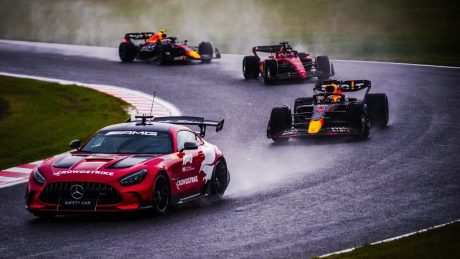The Japanese Formula 1 Grand Prix was the subject of shocking scenes once again on 9 October 2022, just over eight years to the day of Jules Bianchi’s fatal accident, Christopher Deacon writes.
While racing in torrential rain with poor visibility, an aquaplaning incident saw Carlos Sainz crash into the safety barrier on lap one. French driver Pierre Gasly was caught up in the aftermath of Sainz’s crash, damaging his car’s front wing and forcing him to return to the pits.
Returning to the track as Gasly passed the scene of Sainz’s accident for a second time, a tractor could be seen trackside, close to the line of racing. The incident caused understandable outrage, with Gasly commenting: “We lost Jules already… We all lost an amazing guy, an amazing driver, for the reasons that we know. Eight years ago, on the same track, in the same conditions, with a crane. How? How today can we see a crane, not only in the gravel, on a racetrack, while we are still on the track? I don’t understand that.” Carlos Sainz added: “If a driver has small aquaplaning or gets out of the racing line and hits a tractor, it’s over. Why risk a tractor on track?”
It appears that during the second lap of the race, a tractor was allowed to enter the trackside to retrieve Sainz’s stricken vehicle. The problem with this decision was that not all the cars had caught up with the safety car. Gasly was still making up ground following his pit stop and needed to pass the recovery tractor at sufficient speed to allow him to catch up with the rest of the drivers behind the safety car.
Reactions to the incident
The race conditions and circumstances in which the tractor entered the race circuit bore a chilling resemblance to those in which Jules Bianchi was catastrophically injured in 2014. More fundamental is the concern that race organisers and those responsible for operational decisions have not learned crucial safety lessons to prevent a tractor from coming trackside during the race and the risk of catastrophic injury this presents to drivers and marshals.
In a statement, the FIA said it had “launched a thorough review of the events involving the deployment of recovery vehicles during the Japanese Grand Prix… to ensure continual improvements of processes and procedures”.
Appendix H of the FIA International Sporting Code sets out the requirements for an intervention on the racetrack during a race. Article 2.6.1 states: “No marshal or vehicle shall enter the circuit perimeter without permission from race control.” It remains unclear whether the race director had given permission for the tractor to enter the circuit before Gasly had caught up with the safety car, even though by the time he was passing the recovery of Sainz’s vehicle, the race had been red-flagged. Transcripts of the communications between race control, the marshals and recovery team will likely be central to piecing together what happened and how the tractor came to be trackside before Gasly was in a safer position.
The strong sentiment and concerns Gasly, Sainz and others expressed after this incident are easy to understand. The FIA is right to have swiftly launched an investigation to determine how these circumstances came about. Regrettably, this does not detract from the fact that Jules’ family had to witness such chilling scenes again.
Jules Bianchi’s father, Philippe, immediately spoke of the lack of respect for his son’s memory. The incident provides a further opportunity to reinforce Jules’ legacy by ensuring that under no circumstances can a tractor or recovery vehicle be trackside while drivers continue to pass the scene of an accident. Systems need to be in place to prevent operational decisions that put drivers at risk in this way. It is hoped that positive safety improvements will be introduced that join the history books alongside the Halo head protection system and be equally lauded for saving drivers’ lives and avoiding serious injury in motorsport.
‘Formula 1 must keep safety at its core’ – City AM article
“We saw Fernando Alonso’s car take off on Sunday at the Circuit of the Americas in Texas but the car was generally fine despite the impact – it shows how far the sport has come in terms of driver safety,” Chris Deacon wrote in a version of this article for City AM published days after the US Grand Prix.
The article notes that the FIA’s investigation concluded that a tractor should not be deployed unless all cars are aligned behind the safety car. The FIA also emphasised the importance of careful consideration of the weather conditions and location of the cars before race control takes the decision to allow a tractor to enter the circuit. The FIA has immediately introduced measures to ensure drivers are made aware when a recovery vehicle is on the track.
You can find further information regarding our expertise, experience and team on our International Injury page.
If you require assistance from our team, please contact us.
Subscribe – In order to receive our news straight to your inbox, subscribe here. Our newsletters are sent no more than once a month.





